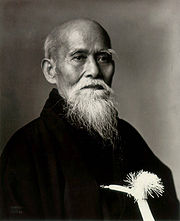|
 |
Aikido (合気道) is a Japanese martial art developed in the early
20th century by a martial arts practitioner called Morihei Ueshiba(1883-1969) from the
traditional fighting art of Daito Ryu Aiki Jujutsu which Ueshiba
studied directly with Takeda Sokaku, the reviver of that art. Additionally,
Ueshiba is known to have studied Tenjin Shin'yō-ryū with Tozawa Tokusaburō
in Tokyo in 1901, Gotōha Yagyū Shingan-ryū under Nakai Masakatsu in Sakai
from 1903 to 1908, and judo with Kiyoichi Takagi (高木 喜代子 Takagi Kiyoichi,
1894–1972) in Tanabe in 1911.
Aikido is a synthesis of
his martial studies, philosophy, and religious beliefs. Ueshiba's goal was to create an art that practitioners
could use to defend themselves while also protecting their attacker from
injury. |
 |
|
The
primary aim of Aikido is the use of an opponents momentum as the means of
defending oneself against an attack as opposed to the use of strength or
aggression.
The name Aikido is often translated as "the Way of unifying life energy"
/ "the Way of harmonious spirit."
The word
"aikido" is formed of three kanji:
合 - ai - joining, harmonizing
気 - ki - spirit, life energy
道 - do - way, path
The term
dō connects the practice of aikido with the philosophical concept of Tao,
which can be found in martial arts such as judo and kendo, and in more
peaceful arts such as Japanese calligraphy (shodō), flower arranging (kadō)
and tea ceremony (chadō or sadō). The term aiki refers to the martial arts
principle or tactic of blending with an attacker's movements for the purpose
of controlling their actions with minimal effort.One applies aiki by
understanding the rhythm and intent of the attacker to find the optimal
position and timing to apply a counter-technique. Historically, aiki was
mastered for the purpose of killing; however in aikido one seeks to control
an aggressor without causing harm.
The founder of aikido declared: "To
control aggression without inflicting injury is the Art of Peace."
A number
of aikido practitioners interpret aikido metaphorically, seeing parallels
between aikido techniques and other methods for conflict resolution.These
kanji are identical to the Korean versions of the characters that form the
word hapkido, a Korean martial art. Although there are no known direct
connections between the two arts, it is suspected that the founders of both
arts trained in Daitō-ryū Aiki-jūjutsu
|













